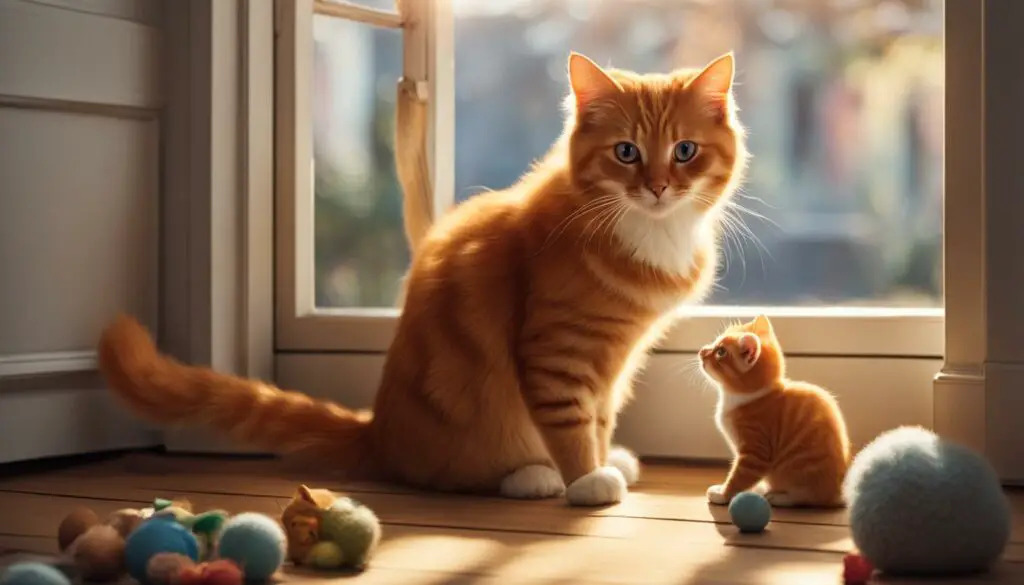I recently brought home a new kitten, excited about the prospect of having two furry friends to keep each other company. However, it didn’t take long for me to realize that my older cat was not as thrilled about the idea as I was. In fact, she seemed downright mad at me! If you’ve found yourself in a similar situation, where your cat is displaying signs of aggression, jealousy, or territorial behavior after introducing a new kitten, don’t worry. I’m here to offer you some tips and solutions to help you navigate this tricky situation and create a harmonious environment for both cats.
Introducing a new cat to your home can be a challenging process, especially when you have an older cat who is not used to sharing their space. Understanding feline behavior and the reasons behind their jealousy is the first step in finding appropriate solutions. With gradual introductions, creating separate spaces, scent swapping, visual contact, and controlled physical introductions, you can help your cats adjust to each other’s presence. Providing individual attention and resources, along with patience and time for adjustment, are crucial in ensuring a peaceful coexistence. And if all else fails, don’t hesitate to seek the help of a professional behaviorist or veterinarian.
Key Takeaways:
- Introducing a new kitten to an older cat can lead to feline jealousy and aggression.
- Understanding your cat’s behavior and the reasons behind their jealousy is crucial.
- Gradual introductions and creating separate spaces can help cats adjust to each other.
- Scent swapping and visual contact with a barrier can facilitate familiarity between cats.
- Controlled physical introductions should be done in a neutral area with supervision.
Understanding Feline Behavior and Jealousy
Cats are known for their independent and sometimes aloof nature, but they can also experience feelings of jealousy when faced with a new addition to the family. Understanding your cat’s behavior and the reasons behind their jealousy is crucial in finding appropriate solutions to help them adjust and coexist peacefully.
Jealousy in cats can manifest in various ways, including aggression, hissing, or avoidance behaviors. It is essential to observe your cat’s body language and reactions when introducing a new cat into the household. This will give you insights into their emotions and help you determine the best course of action.
Cats may exhibit territorial behavior as a response to a new cat’s presence. They see their home as their territory and may feel threatened by the intrusion. This territoriality can lead to aggressive behavior as cats try to establish dominance or protect their resources. Recognizing these signs of jealousy and territoriality is the first step in addressing the issue and creating a harmonious environment for both cats.
| Signs of Feline Jealousy | Possible Solutions |
|---|---|
| Aggressive behavior towards the new cat | Gradual introductions and controlled physical interactions |
| Hissing, growling, or spitting | Creating separate spaces and providing individual attention and resources |
| Avoidance or hiding | Using scent swapping and visual contact with a physical barrier |
By understanding the underlying reasons for your cat’s jealousy and territorial behavior, you can implement strategies that address their needs and reduce stress. Patience, consistency, and providing individual attention and resources are key to helping your cats adjust to each other and form a bond over time.
Gradual Introductions and Creating Separate Spaces
Introducing a new cat to your home requires careful consideration and planning to ensure a smooth transition for both your existing cat and the newcomer. Gradual introductions and creating separate spaces are key steps in helping cats adjust and overcome any potential aggression or territorial behavior.
Firstly, it’s important to provide separate litter boxes, feeding areas, and sleeping spaces for each cat. This helps minimize competition and reduces the likelihood of territorial disputes. Each cat should have their own designated areas where they feel safe and comfortable.
Additionally, gradual introductions play a vital role in allowing the cats to acclimate to each other’s presence. Start by swapping scents between the cats. You can do this by exchanging bedding or using a cloth to transfer scents. This helps familiarize them with each other’s smell and facilitates a more gradual introduction.
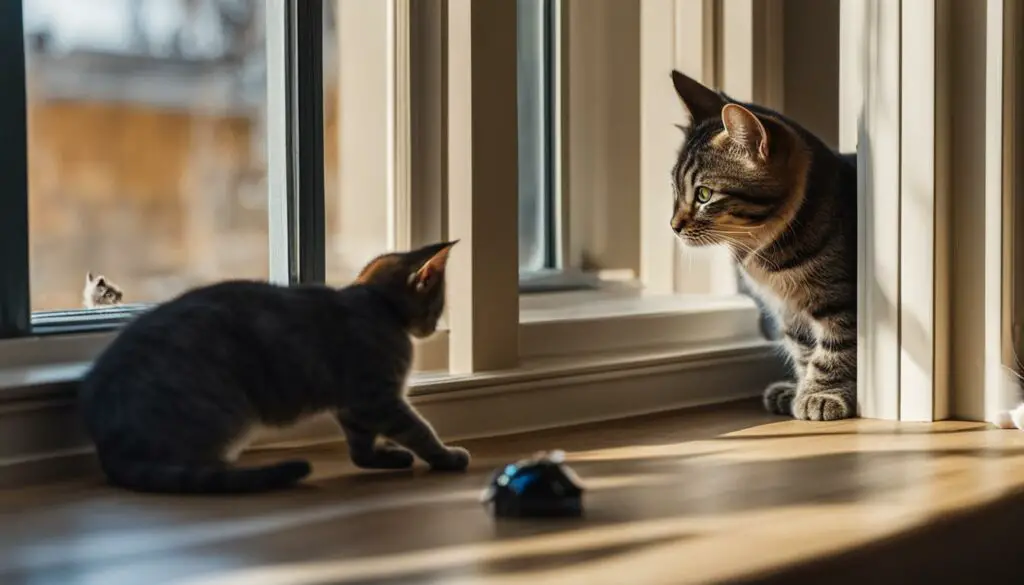
During the initial stages, it’s important to allow visual contact while maintaining a physical barrier. This can be achieved by using a baby gate or crate to separate the cats. This allows them to observe each other without direct physical interaction, gradually getting used to each other’s presence.
In summary, gradual introductions and creating separate spaces are crucial in helping cats adjust and form a harmonious relationship. By providing individual resources and allowing for controlled visual and physical interactions, you can facilitate a peaceful coexistence between your cats.
Scent Swapping and Familiarization
Introducing cats to each other can be a delicate process, especially when it comes to dealing with territorial behavior. One effective method to help cats familiarize themselves with each other’s presence is through scent swapping. By exchanging bedding or using a cloth to transfer scents between the cats, you can facilitate the gradual acceptance of their new housemate.
Scent swapping allows the cats to become accustomed to each other’s scent without direct confrontation, reducing the potential for territorial aggression. This method helps to create a sense of familiarity and can alleviate some of the stress associated with introductions. It is important to be patient during this process, as each cat may require a different amount of time to adjust.
How to do scent swapping:
- Observe the cats and identify which bedding or cloth has their individual scent.
- Take the bedding or cloth from one cat’s area and place it in the other cat’s space.
- Allow the cats to explore the scented item at their own pace.
- Repeat the process with the other cat’s bedding or cloth.
By gradually introducing each cat to the other’s scent, you are helping them build positive associations and recognize each other as part of the same household. This method can pave the way for smoother introductions and minimize the risk of territorial conflicts.
| Scent Swapping Benefits: | Scent Swapping Tips: |
|---|---|
|
|
Remember, each cat is unique, and the introduction process may take time. Be patient, provide plenty of positive reinforcements, and seek professional guidance if needed. With scent swapping and familiarization, your cats can gradually adjust to each other and coexist peacefully.
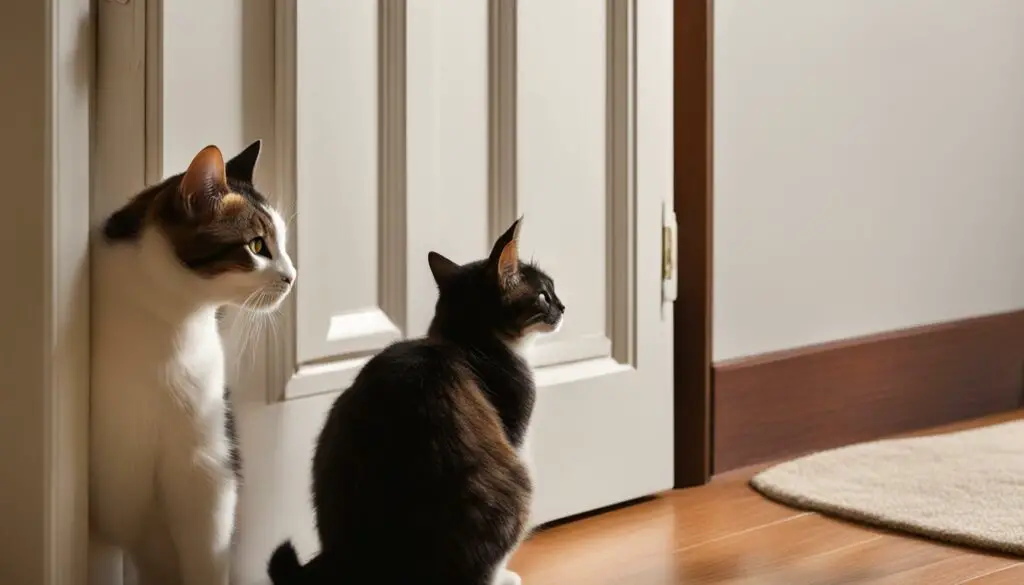
Visual Contact and Barrier Separation
When introducing cats to each other, it is important to allow them to have visual contact while maintaining a physical barrier. This gradual approach helps the cats become familiar with each other’s presence without feeling threatened or overwhelmed.
To achieve visual contact with barrier separation, you can use a baby gate or crate to separate the cats in different areas of the room. This allows them to see and observe each other from a safe distance. It is essential to ensure that the barrier is secure and stable to prevent any accidents or escape.
Visual contact with barrier separation serves multiple purposes. It allows the cats to become accustomed to each other’s scent and appearance without direct physical interaction. This gradual exposure helps reduce the likelihood of aggressive behavior and allows the cats to gradually adjust and feel more comfortable around each other.
During this phase, it is essential to closely monitor the cats’ behavior. Look for signs of aggression such as hissing, growling, or aggressive body language. If any signs of aggression occur, it may be necessary to revert to previous steps or consult a professional behaviorist for further guidance.
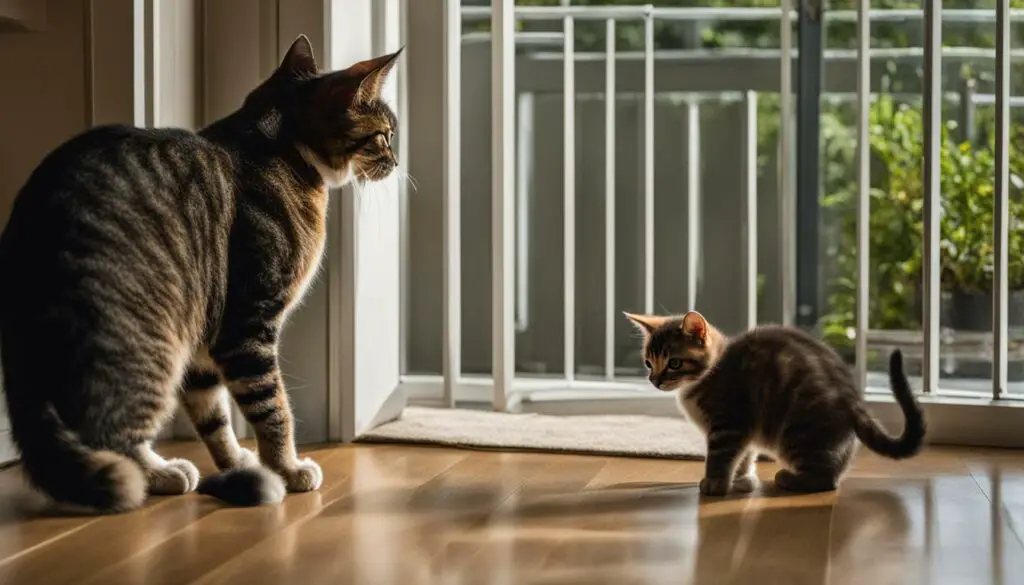
Visual Contact and Barrier Separation: Tips
- Ensure the barrier between the cats is secure and sturdy.
- Allow the cats to have visual contact for short periods and gradually increase the duration.
- Observe the cats’ body language and behavior during visual contact. Look for signs of stress or aggression.
- Provide positive reinforcement, such as treats or praise, when the cats display calm and relaxed behavior during visual contact.
- If the cats show signs of aggression, separate them immediately and consult a professional behaviorist for assistance.
Table: Comparison of Visual Contact and Barrier Separation Methods
| Method | Advantages | Disadvantages |
|---|---|---|
| Using a baby gate | Allows for visual contact while maintaining a physical barrier | May not be suitable for homes with cats that can easily jump over the gate |
| Using a crate | Provides a secure and confined space for both cats | Requires careful monitoring to ensure the cats’ safety and well-being |
Controlled Physical Introductions
Once the cats have shown positive responses to visual contact, it is time to proceed to controlled physical introductions. This step involves allowing the cats to interact in a neutral area where neither cat feels threatened or territorial. The purpose of this is to gradually acclimate them to each other’s presence and ensure a safe and peaceful coexistence.
During the controlled physical introductions, it is essential to closely supervise the cats to prevent any potential aggressive behavior. Keep in mind that each cat has its own personality and may react differently to the situation. Some cats may be more receptive and curious, while others may be more cautious or defensive. Patience is key during this process.
If any signs of aggression or tension arise during the physical introductions, it is important to separate the cats and give them space to calm down. You can then try the introductions again later, gradually increasing the duration and monitoring their behavior. Remember, forcing interactions can lead to heightened stress levels and setbacks in the adjustment process.
By taking the time to carefully introduce your cats to each other in a controlled manner, you are allowing them to establish their own boundaries and gradually build a positive relationship. Through patience and supervision, you can help them overcome their initial territorial behaviors and develop a harmonious coexistence.
| Benefits of Controlled Physical Introductions | Tips for Controlled Physical Introductions |
|---|---|
|
|
Remember, introducing cats to each other requires patience, understanding, and a gradual approach. Controlled physical introductions are an important step in the process and should be carried out with caution. With consistent efforts and positive reinforcement, your cats can learn to coexist peacefully and even form a bond over time.
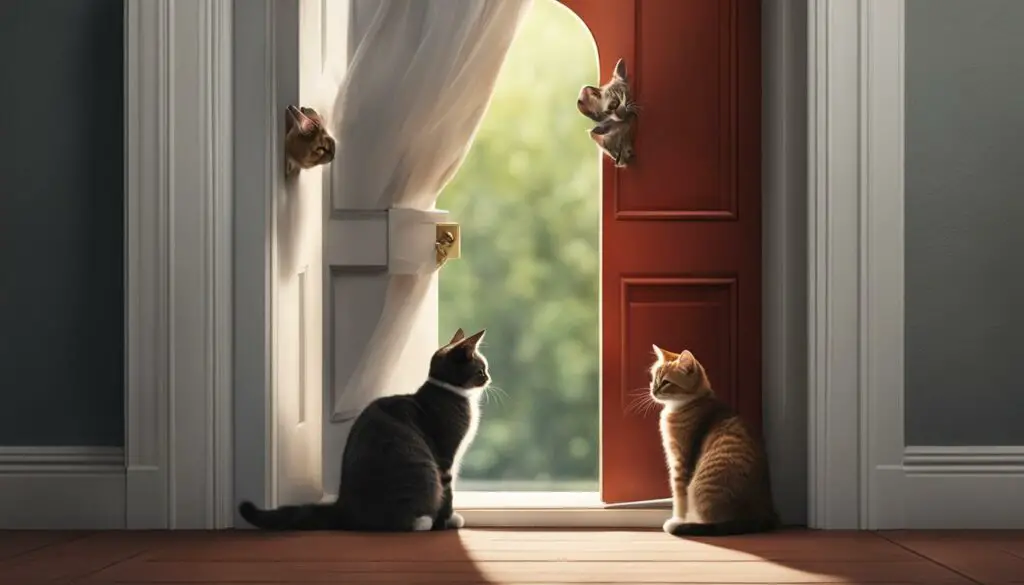
Providing Individual Attention and Resources
When introducing a new cat to your home, it’s important to ensure that each cat receives individual attention and resources. This helps prevent feelings of jealousy and competition, and promotes a harmonious environment for both cats.
One way to provide individual attention is through separate playtime sessions. Set aside dedicated time each day to engage in play with each cat, using toys that they enjoy. This not only provides mental and physical stimulation but also helps strengthen the bond between you and your cats.
In addition to playtime, it’s essential to ensure that each cat has their own toys, food, and water bowls. This prevents any sense of ownership or territorial behavior over these resources. Having separate litter boxes is also crucial, as cats are quite particular about their bathroom habits and may become stressed if forced to share.
| Resources | Older Cat | New Kitten |
|---|---|---|
| Playtime | Dedicate at least 15 minutes of interactive playtime each day. | Dedicate at least 15 minutes of interactive playtime each day. |
| Toys | Provide a variety of toys that your older cat enjoys. | Provide a variety of toys suitable for a kitten’s age and development. |
| Food and Water Bowls | Ensure each cat has their own set of food and water bowls. | Ensure each cat has their own set of food and water bowls. |
| Litter Boxes | Provide separate litter boxes for each cat, placed in different areas of the house. | Provide a separate litter box for the new kitten in a quiet and accessible location. |
By providing individual attention and resources, you can ensure that each cat feels valued, loved, and secure in their own space.
Patience and Time for Adjustment
Introducing a new cat to your home can be an exciting but challenging experience, especially when dealing with cat jealousy. It’s important to remember that each cat is an individual with their own unique personality and temperament. Some cats may adjust quickly and form a bond with the new addition, while others may take more time and patience.
During the adjustment period, it’s crucial to give both cats the time and space they need to acclimate to each other. Avoid rushing the process and forcing interactions, as this can lead to increased stress and aggression. Instead, provide each cat with their own separate spaces and resources, such as feeding areas, litter boxes, and resting spots. This will help them feel secure and reduce territorial conflicts.
It’s natural for cats to initially show signs of jealousy or curiosity when a new cat enters their territory. They may hiss, growl, or even avoid each other. This behavior is normal and should be expected. Over time, as they become more familiar with each other’s scents and presence, they will gradually adjust and hopefully develop a positive relationship.
Remember to observe and monitor their interactions closely, especially during controlled physical introductions. If any signs of aggression or hostility persist, it may be necessary to consult with a professional behaviorist or veterinarian for further guidance. They can provide valuable insights and recommend behavior modification techniques if needed.
Key Points:
- Be patient and allow each cat to set their own pace for adjustment.
- Provide separate spaces and resources for each cat to alleviate territorial conflicts.
- Expect initial signs of jealousy or curiosity and give them time to become familiar with each other.
- Monitor interactions closely and seek professional help if aggression persists.
| Introducing a New Cat: Tips for Dealing with Cat Jealousy | |
|---|---|
| Be patient and allow each cat to adjust at their own pace. | |
| Provide separate spaces and resources for each cat to minimize territorial conflicts. | |
| Gradually introduce them through scent swapping and visual contact. | |
| Monitor their interactions closely and seek professional help if needed. |
Behavior Modification and Training
When dealing with cat aggression, jealousy, or territorial behavior, behavior modification and training techniques can be effective in addressing and modifying these unwanted behaviors. By using positive reinforcement training methods, you can encourage desired behaviors and discourage or redirect negative ones.
One approach is to reward your cat with treats or praise when they exhibit calm and non-aggressive behavior. This positive reinforcement helps to reinforce good behavior and can help to reduce aggressive tendencies over time. It is important to be consistent and patient with the training process, as behavior modification may take some time.
In addition to positive reinforcement, redirecting your cat’s attention to more appropriate outlets can help alleviate aggression or territorial behavior. Providing interactive toys, scratching posts, and engaging play sessions can help redirect their energy and focus to more acceptable activities.
Consulting with a professional behaviorist or veterinarian can provide valuable guidance and support. They can assess the specific behavior issues and tailor a behavior modification plan that suits your cat’s individual needs. They may also recommend additional training techniques or strategies to further address the aggression or jealousy concerns.
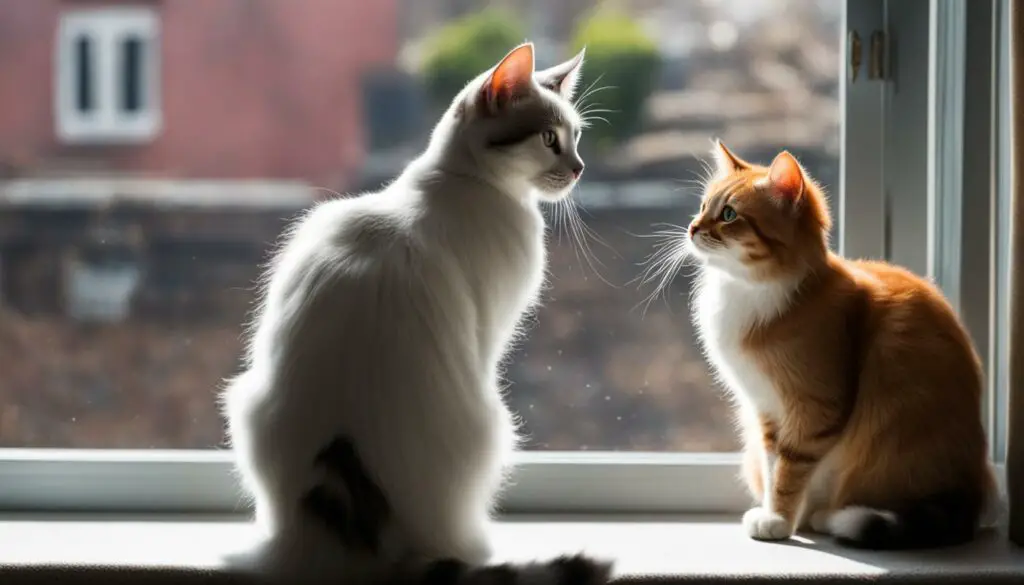
Example Table: Behavior Modification Techniques
| Technique | Description |
|---|---|
| Positive Reinforcement | Rewarding desired behavior with treats or praise to encourage its repetition. |
| Redirected Play | Providing toys and interactive play sessions to redirect energy and focus to appropriate activities. |
| Desensitization | Gradually exposing your cat to triggers that cause aggression or jealousy to help them become more tolerant over time. |
| Counterconditioning | Pairing the presence of a trigger that causes aggression or jealousy with positive experiences, such as treats or playtime, to associate positive emotions with the trigger. |
Ensuring a Peaceful Coexistence
When introducing cats to each other, it’s important to take steps to promote a peaceful coexistence. While complete friendship may not always be possible, with time and effort, you can help your cats establish their own boundaries and minimize conflicts. Here are some strategies to ensure a harmonious environment:
Create Separate Spaces
| Cat 1 | Cat 2 |
|---|---|
| Provide separate litter boxes, feeding areas, and sleeping spaces. | Respect their need for personal space and reduce competition. |
Gradual Introductions
- Start by allowing the cats to smell each other’s scent through scent swapping techniques.
- Gradually progress to visual contact with a barrier separation, such as a baby gate or crate.
- Once they show positive responses, proceed to controlled physical introductions in a neutral area.
Individual Attention and Resources
- Ensure both cats receive individual attention, playtime, and grooming sessions.
- Provide separate toys, food bowls, and water bowls to prevent jealousy and competition.
By following these strategies and maintaining a positive and consistent environment, you can help your cats coexist peacefully. Remember, each cat may have a different timeline for acceptance, so patience is key. If you encounter difficulties, don’t hesitate to seek professional help from a behaviorist or veterinarian.
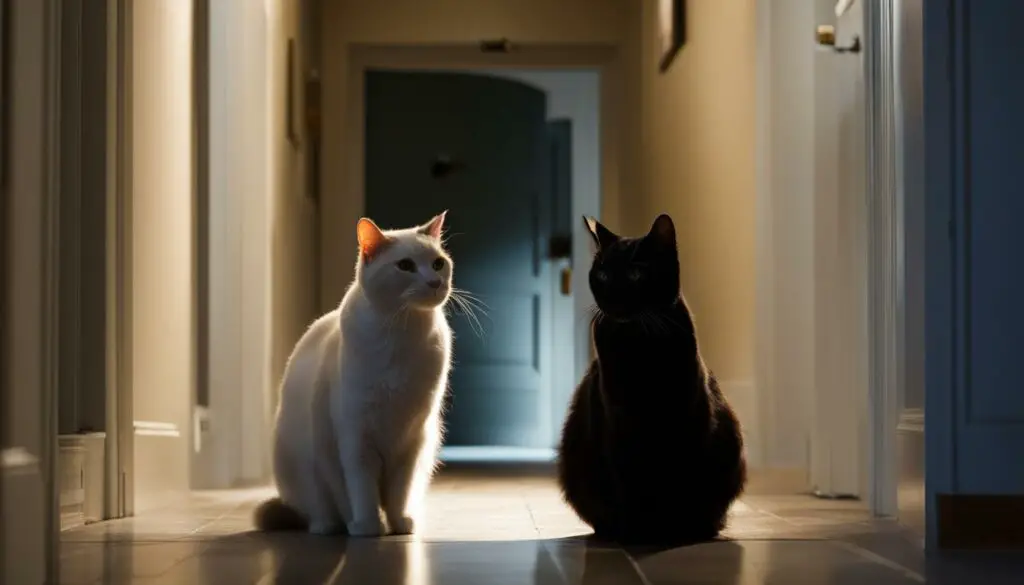
Seeking Professional Help
Dealing with cat jealousy, aggression, and territorial behavior can be challenging, especially when introducing a new cat to your home. While there are many tips and solutions you can try on your own, there may come a point when seeking professional help becomes necessary. Consulting with a professional behaviorist or veterinarian who specializes in cat behavior can provide you with expert guidance and support.
A professional behaviorist or veterinarian can assess your specific situation and develop a customized plan to address your cat’s jealousy and aggression. They have extensive knowledge and experience in understanding feline behavior and can provide you with valuable insights and strategies that you may not have considered.
When to Seek Professional Help
If you notice that despite your best efforts, your cats are not adjusting to each other, or their aggression and territorial behavior are escalating, it may be time to reach out for professional help. Some signs that indicate the need for professional intervention include:
- Severe aggression, such as frequent fights or injuries
- Uncontrolled spraying or marking behaviors
- Intense and persistent episodes of jealousy or territorial behavior
- Extreme stress or anxiety exhibited by either cat
By seeking professional help, you can ensure that you are taking the right approach to address the specific issues your cats are facing. Remember, with the right guidance and support, you can help your cats overcome their jealousy and aggression, creating a peaceful and harmonious home environment for everyone.

Creating a Positive Environment
When introducing a new cat to your home, it is crucial to create a positive environment that fosters a sense of comfort and security. By following these tips, you can help your cats adjust and form a harmonious bond.
1. Provide Plenty of Enrichment Activities
Enrichment activities are essential for keeping your cats mentally and physically stimulated. Offer a variety of toys, scratching posts, and interactive games to engage their natural instincts and prevent boredom. Consider rotating toys to keep things interesting and provide different types of stimulation.
2. Engage in Interactive Playtime
Interactive playtime sessions are a great way to bond with your cats and encourage positive interactions between them. Use interactive toys, such as feathers on a stick or laser pointers, to engage their natural hunting instincts. Set aside regular play sessions where you can actively engage with each cat individually, ensuring they both receive attention and playtime.
3. Incorporate Vertical Spaces
Cats enjoy having vertical spaces where they can climb and observe their surroundings. Provide tall cat trees or shelves strategically placed near windows, allowing your cats to look outside and enjoy a change of scenery. Vertical spaces also create additional territory, reducing the likelihood of territorial disputes between your cats.
| Creating a Positive Environment | Benefits |
|---|---|
| Enrichment activities | Prevents boredom and provides mental stimulation |
| Interactive playtime | Bonds with your cats and encourages positive interactions |
| Incorporate vertical spaces | Provides climbing opportunities and reduces territorial disputes |
By implementing these strategies and creating a positive environment for your cats, you can help them adjust to each other’s presence and foster a calm and harmonious household. Remember to be patient and allow each cat to progress at their own pace, ensuring they feel safe and secure in their new environment.
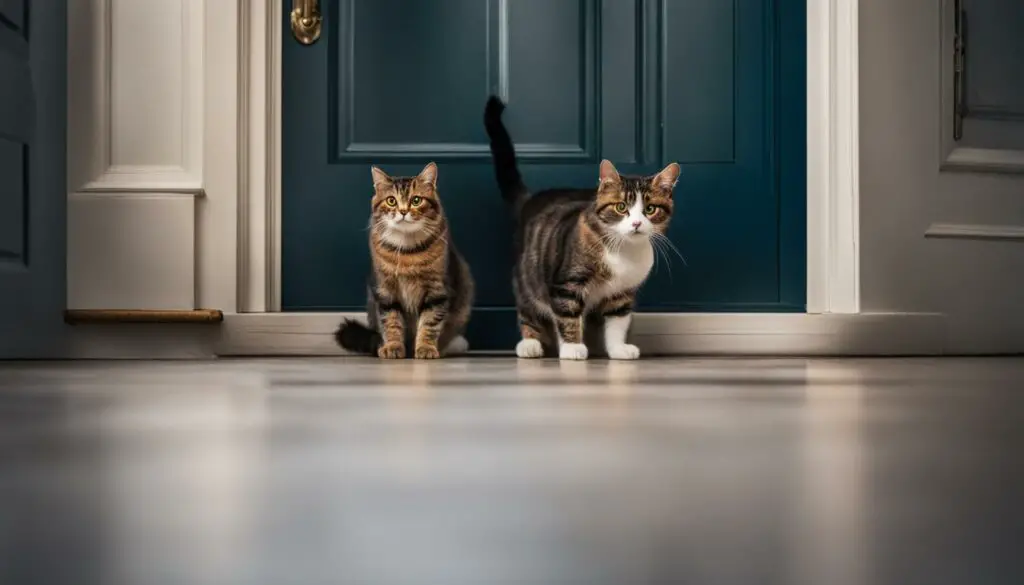
Maintaining Consistency and Routine
When introducing a new cat to your home, it’s important to establish and maintain consistency and routine to help both cats feel secure and comfortable. Consistency provides a sense of stability and predictability, which can reduce stress and promote positive interactions between the cats.
One way to maintain consistency is by sticking to a regular feeding schedule. Cats are creatures of habit and thrive on routine, so feeding them at the same time each day can create a sense of security. Additionally, providing separate food and water bowls for each cat will prevent competition and potential disputes over resources.
In addition to feeding, it’s essential to establish a consistent playtime routine. Playtime not only provides mental and physical stimulation for the cats but also strengthens the bond between you and your pets. Set aside dedicated play sessions for each cat, ensuring that they receive individual attention and engagement. This can help alleviate feelings of jealousy and promote a harmonious environment.
Creating a Peaceful Environment
Creating a peaceful environment for your cats is another crucial aspect of maintaining consistency. Each cat should have their own territory and spaces to retreat to when they need some alone time. Providing separate sleeping areas and comfortable hiding spots can help reduce conflicts and promote a sense of individuality.
Additionally, consider using pheromone diffusers or sprays to create a calm and soothing atmosphere. Pheromones mimic the natural scents that cats release when they feel safe and secure, helping to reduce stress and promote relaxation in both cats.
| Consistency and Routine Tips: |
|---|
| Stick to a regular feeding schedule |
| Provide separate food and water bowls |
| Establish dedicated playtime routines for each cat |
| Offer individual sleeping areas and hiding spots |
| Consider using pheromone diffusers or sprays |
By maintaining consistency and routine, you can create a stable and harmonious environment for both cats. Remember to provide individual attention, respect their need for personal space, and seek out professional help if needed. With time, patience, and dedication, your cats can coexist peacefully and form a bond that will enrich both their lives and yours.
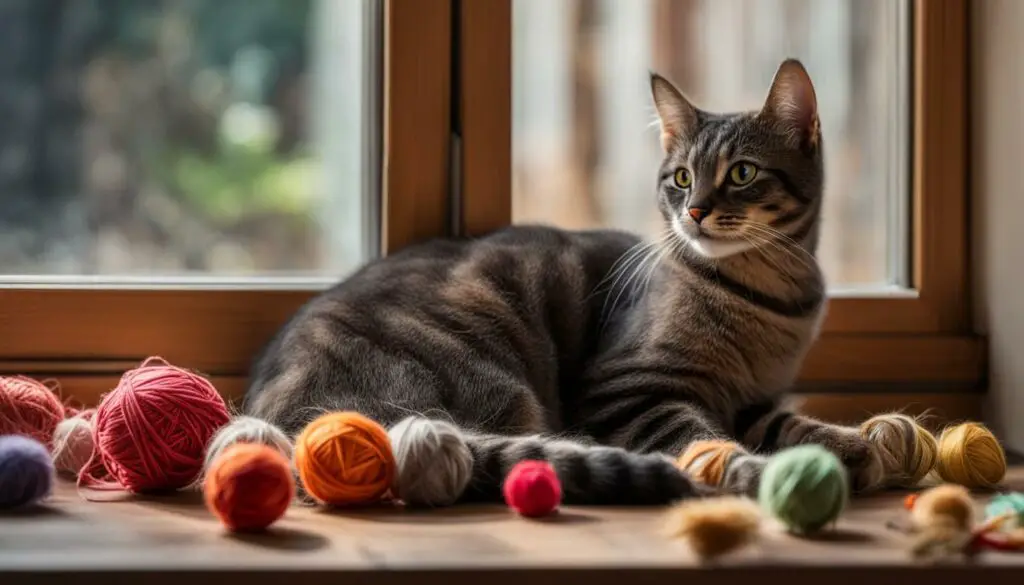
Conclusion
Bringing a new kitten into a home with an older cat can be a challenging time for both feline companions and their human caretakers. However, with patience, understanding of cat behavior, and the right approach, you can help them adjust and create a harmonious environment for everyone involved.
Remember that cats may experience feelings of jealousy and territoriality when faced with a new addition to the family. It’s important to understand their behavior and the reasons behind their reactions in order to find appropriate solutions.
Gradual introductions and creating separate spaces for each cat can go a long way in helping them adjust to each other’s presence. Providing unique resources and maintaining consistent routines will also help reduce stress and promote positive interactions. If needed, don’t hesitate to seek professional help from a behaviorist or veterinarian.
Keep in mind that while complete friendship between the cats may not always be achieved, a peaceful coexistence is a realistic goal. With time, effort, and plenty of love, your cats can learn to coexist peacefully and even form a bond that enriches their lives and yours.
FAQ
What should I do if my cat is mad at me for bringing home a kitten?
If your cat is showing aggression or jealousy towards the new kitten, there are several tips and solutions you can try to help them adjust and create a harmonious environment.
Why is my cat behaving aggressively towards the new kitten?
Cats can experience feelings of jealousy and territoriality when faced with a new addition to the family. Understanding your cat’s behavior and the reasons behind their jealousy is crucial in finding appropriate solutions.
How can I introduce a new kitten to my older cat?
Gradual introductions and creating separate spaces for each cat is essential in helping them adjust to each other’s presence. This includes providing separate litter boxes, feeding areas, and sleeping spaces to minimize competition and territorial disputes.
How can scent swapping help my cats get used to each other?
Scent swapping is an effective method to help cats familiarize themselves with each other’s presence. This can be done by exchanging bedding or using a cloth to transfer scents between the cats. It allows them to become accustomed to each other’s scent and reduces the potential for territorial aggression.
Should I allow my cats to have visual contact with each other?
Allowing cats to have visual contact with each other while maintaining a physical barrier can help them gradually get used to each other’s presence. This can be achieved by using a baby gate or crate to keep them separated but still visible to each other.
How can I safely introduce my cats to each other physically?
Once the cats have shown positive responses to visual contact, controlled physical introductions can be made. This should be done in a neutral area where neither cat feels threatened or territorial. Supervision is essential during these interactions to ensure safety and prevent aggressive behavior.
How can I prevent feelings of jealousy and competition between my cats?
It is important to provide individual attention and resources to each cat to prevent feelings of jealousy and competition. This includes separate playtime, grooming sessions, and ensuring each cat has their own toys, food, and water bowls.
How long will it take for my cats to adjust to each other?
Adjusting to a new cat can take time and patience. It is important to allow both cats to set their own pace and not rush the process. Each cat may have a different timeline for acceptance, and forcing interactions can lead to more stress and aggression.
What should I do if the introductions are not going well?
If the introductions and adjustments are not going well, it may be beneficial to seek the assistance of a professional behaviorist or veterinarian. They can provide specialized guidance and recommend additional strategies to address specific issues.
How can I create a positive environment for both cats?
Creating a positive environment for both cats is crucial in helping them adjust and form a harmonious bond. This includes providing plenty of enrichment activities, interactive toys, and engaging playtime sessions to keep them mentally and physically stimulated.
Why is consistency and routine important for cats?
Consistency and routine are key factors in helping cats feel secure and comfortable. Maintaining a consistent feeding schedule, playtime routine, and providing familiar spaces can help reduce stress and promote positive interactions between the cats.

